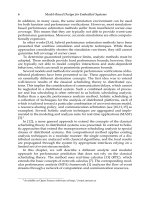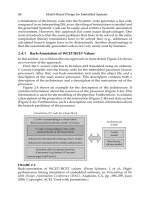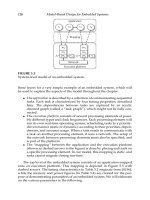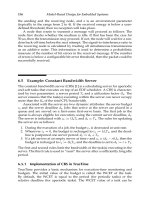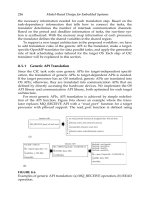Model-Based Design for Embedded Systems- P60 docx
Bạn đang xem bản rút gọn của tài liệu. Xem và tải ngay bản đầy đủ của tài liệu tại đây (251.39 KB, 10 trang )
Nicolescu/Model-Based Design for Embedded Systems 67842_C017 Finals Page 576 2009-10-2
576 Model-Based Design for Embedded Systems
g at t
n−1
+ 0.5h
n
and t
n−1
+ 0.75h
n
, we must fire but not postfire these actors.
Postfiring the actors would erroneously commit them to state updates before
we know whether the step size h
n
is valid. Thus, in effect, the solver must
provide them with tentative inputs at each tag (one tag for each of these
time values), as shown in Equations 17.5 and 17.6, and find a fixed point at
that tag. But it must not commit the actors to any state changes until it is
sure of the step size. Avoiding invocation of the postfire method successfully
avoids these state changes, as long as all actors conform to the actor abstract
semantics. This mechanism is similar to that used in Simulink, where the
model_update method is not invoked until a simulation step is concluded.
We can now see that CT operates similar to DE models, with the only
real difference being that in addition to using an event queue to determine
the advancement of time, we must also consult an ODE solver. The same
fireAt mechanism that we used in DE would be adequate, but for efficiency
we have chosen to use a different mechanism that polls relevant actors for
their constraintson theadvancement oftime andaggregates theresults. Inour
implementation, any actor can assert that it wishes to exert some influence on
the passage of time by implementing a ContinuousStepSizeController interface.
All such actors will be consulted before time is advanced. The Integrator
actors implement this interface and serve as proxies for the solver. But given
this general mechanism, there are other useful actors that also implement
this interface. For example, the LevelCrossingDetector actor implements this
interface. Given a CT input signal, it looks for tags at which the value of the
signal crosses some threshold given as a parameter. If a step size results in a
crossingofthethreshold,theactorwillexertcontroloverthestepsize,reducing
it until the time of the crossing is identified to some specified precision.
Since the CT director only assumes that component actors conform to the
actor abstract semantics, these actors can be opaque composite actors that
internally contain SR or DE models. Moreover, a CT model can now form an
opaque composite actor that exports the actor abstract semantics, and hence
CT models can be included within SR or DE models and vice versa (subject
again to the constraint that if SR is at the top level, then it must be explicit
about time).
A simple example is shown in Figure 17.8. The top-level model is DE rep-
resenting a sequence of discrete jobs with increasing service requirements.
For each job, a random (exponential) service rate is generated. The inside
model uses a single integrator to model the (continuous) servicing of the job
and a level-crossing detector to detect completion of the job.
17.8 Software Implementation
A prototype of the techniques described here in Ptolemy II is available in an
open-source form (BSD-style license) at . We started with
Nicolescu/Model-Based Design for Embedded Systems 67842_C017 Finals Page 577 2009-10-2
Mixed Continuous and Discrete Systems 577
DE director
Ramp
ColtExponential
Job processor
TimedDelay
Delay of
0.0
Falling
0.0
TimedPlotter
TimedPlotter
Continuous director
ZeroOrderHold
AddSubtract
+
–
LevelCrossingDetector2
JobDone
Job
Rate
ZeroOrderHold3 Integrator2
Trigger
Lambda
FIGURE 17.8
CT opaque composite actor within a DE model.
the SRDirector created by Whitaker [48], which was based on an SR direc-
tor in Ptolemy classic created by Edwards and Lee [17]. We then used this
director as a base class for a new ContinuousDirector. Unlike the predecessor
CTDirector created by Liu [37], this new director realizes a fixed point seman-
tics at each discrete time point. The discrete time points are selected from the
time continuum, as explained above, in response to actors that invoke fireAt
and actors that implement ContinuousStepSizeController. The latter include
integrator actors, which use an underlying ODE solver with variable step
size control.
We modified SRDirector and implemented ContinuousDirector so that
both now rigorously export the actor abstract semantics. That is, when the
fire method of either director is invoked, the director does not commit to any
state changes, and it does not invoke postfire on any actors contained in its
composite. Thus, if those actors conform to the actor abstract semantics, then
so does the opaque composite actor containing the director.
Nicolescu/Model-Based Design for Embedded Systems 67842_C017 Finals Page 578 2009-10-2
578 Model-Based Design for Embedded Systems
These improvements led to significant improvements in simplicity and
usability. Before we had a menagerie of distinct versions of CTDirector,but
now we only need one. Previously, in order to compose CT models with
other MoCs (such as DE for mixed signal models and FSM for modal models
and hybrid systems), we needed to implement specialized cross-hierarchy
operations to coordinate the speculative execution of the ODE solver with
the environment. This resulted in distinct directors for use inside opaque
composite actors and inside modal models.
We also acquired the ability to put SR inside CT models. This is extremely
convenient, because SR can be used to efficiently specify numeric compu-
tations and complex decision logic, where the continuous dynamics of CT
is irrelevant and distracting. Note that it would be much more difficult to
use dataflow models, such as SDF [31] inside CT models. This is because in
dataflow models, communication between actors is queued. In order to sup-
port the speculative executions that an ODE solver performs, we would have
to be able to backtrack the state of the queues. This would add considerable
complexity. SR has no such difficulty.
Since the CT MoC is a generalization of the SR, in principle, SR becomes
unnecessary. However, SR is much simpler, not requiring the baggage of
support for ODE solvers, and hence is more amenable to formal analysis,
optimization, and code generation.
17.9 Conclusions
In this chapter, we explain an operational semantics that supports mixtures
of SR, DE, and CT MoC, and outline a corresponding denotational semantics.
Dialects of DE and CT are developed that generalize SR, but provide com-
plementary modeling and design capabilities. We show that the three MoCs
can be combined hierarchically in arbitrary order.
Acknowledgments
We thank to Jie Liu, Xiaojun Liu, Eleftherios Matsikoudis, and Reinhard von
Hanxleden for their major contributions to our understanding of this topic,
to the software on which we base this chapter, and to the contents of this
chapter.
The work described in this chapter was supported in part by the Cen-
ter for Hybrid and Embedded Software Systems (CHESS) at UC Berke-
ley, which receives support from the National Science Foundation (NSF
Nicolescu/Model-Based Design for Embedded Systems 67842_C017 Finals Page 579 2009-10-2
Mixed Continuous and Discrete Systems 579
awards #0720882 (CSR-EHS: PRET), #0647591 (CSR-SGER), and #0720841
(CSR-CPS)), the U. S. Army Research Office (ARO #W911NF-07-2-0019), the
U. S. Air Force Office of Scientific Research (MURI #FA9550-06-0312 and AF-
TRUST #FA9550-06-1-0244), the Air Force Research Lab (AFRL), the State
of California Micro Program, and the following companies: Agilent, Bosch,
HSBC, Lockheed-Martin, National Instruments, and Toyota.
References
1. G. A. Agha, I. A. Mason, S. F. Smith, and C. L. Talcott. A foundation for
actor computation. Journal of Functional Programming, 7(1):1–72, 1997.
2. R. Alur, T. Dang, J. Esposito, Y. Hur, F. Ivancic, V. Kumar, I. Lee,
P. Mishra, G. J. Pappas, and O. Sokolsky. Hierarchical modeling and
analysis of embedded systems. Proceedings of the IEEE, 91(1):11–28,
2003.
3. A. Basu, M. Bozga, and J. Sifakis. Modeling heterogeneous real-time
components in BIP. In International Conference on Software Engineering
and Formal Methods (SEFM), pp. 3–12, Pune, India, September 11–15,
2006.
4. A. Benveniste and G. Berry. The synchronous approach to reactive and
real-time systems. Proceedings of the IEEE, 79(9):1270–1282, 1991.
5. A. Benveniste, L. Carloni, P. Caspi, and A. Sangiovanni-Vincentelli.
Heterogeneous reactive systems modeling and correct-by-construction
deployment. In EMSOFT, Philadelphia, PA, 2003, Springer.
6. G. Berry. The Constructive Semantics of Pure Esterel. Book Draft, 1996.
/>7. G. Berry. The effectiveness of synchronous languages for the develop-
ment of safety-critical systems. White paper, Esterel Technologies, 2003.
8. G. Berry and G. Gonthier. The Esterel synchronous programming lan-
guage: Design, semantics, implementation. Science of Computer Program-
ming, 19(2):87–152, 1992.
9. R. Boute. Integrating formal methods by unifying abstractions. In
E. Boiten, J. Derrick, and G. Smith (editors,) Fourth International Confer-
ence on Integrated Formal Methods (IFM), 2999: Canterbury, Kent, U.K.,
April 4–7, 2004, LNCS, pp. 441–460, Springer-Verlag.
10. C. Brooks, A. Cataldo, C. Hylands, E. A. Lee, J. Liu, X. Liu, S. Neuendorf-
fer, and H. Zheng. HyVisual: A hybrid system visual modeler. Technical
Nicolescu/Model-Based Design for Embedded Systems 67842_C017 Finals Page 580 2009-10-2
580 Model-Based Design for Embedded Systems
report UCB/ERL M03/30, University of California, Berkeley, CA, July
17, 2003.
11. J. T. Buck, S. Ha, E. A. Lee, and D. G. Messerschmitt. Ptolemy: A frame-
work for simulating and prototyping heterogeneous systems. Interna-
tional Journal of Computer Simulation, Special issue on “Simulation Software
Development,” 4:155–182, 1994.
12. L. P. Carloni, M. D. DiBenedetto, A. Pinto, and A. Sangiovanni-
Vincentelli. Modeling techniques, programming languages, and design
toolsets for hybrid systems. Technical Report IST-2001-38314 WPHS,
Columbus Project, June 2004.
13. C. G. Cassandras. Discrete Event Systems, Modeling and Performance Anal-
ysis. Irwin, Boston, MA, 1993.
14. A. Cataldo, E. A. Lee, X. Liu, E. Matsikoudis, and H. Zheng. A construc-
tive fixed-point theorem and the feedback semantics of timed systems. In
Workshop on Discrete Event Systems (WODES), Ann Arbor, MI, July 10–12,
2006.
15. A. Deshpande, A. Gollu, and P. Varaiya. The Shift programming lan-
guage for dynamic networks of hybrid automata. IEEE Transactions on
Automatic Control, 43(4):584–587, 1998.
16. R. Djenidi, C. Lavarenne, R. Nikoukhah, Y. Sorel, and S. Steer. From
hybrid simulation to real-time implementation. In 11th European Simula-
tion Symposium and Exhibition (ESS99), pp. 74–78, Erlangen-Nuremberg,
Germany, October 1999.
17. S. A. Edwards and E. A. Lee. The semantics and execution of a syn-
chronous block-diagram language. Science of Computer Programming,
48(1):21–42, 2003.
18. J. Eker, J. W. Janneck, E. A. Lee, J. Liu, X. Liu, J. Ludvig, S. Neuendorffer,
S. Sachs, and Y. Xiong. Taming heterogeneity—The Ptolemy approach.
Proceedings of the IEEE, 91(2):127–144, 2003.
19. G. S. Fishman. Discrete-Event Simulation: Modeling, Programming, and
Analysis. Springer-Verlag, New York, 2001.
20. P. Fritzson. Principles of Object-Oriented Modeling and Simulation with Mod-
elica 2.1. Wiley, New York, 2003.
21. A. Girault, B. Lee, and E. A. Lee. Hierarchical finite state machines
with multiple concurrency models. IEEE Transactions On Computer-Aided
Design of Integrated Circuits and Systems, 18(6):742–760, 1999.
Nicolescu/Model-Based Design for Embedded Systems 67842_C017 Finals Page 581 2009-10-2
Mixed Continuous and Discrete Systems 581
22. G. Goessler and A. Sangiovanni-Vincentelli. Compositional modeling
in Metropolis. In Second International Workshop on Embedded Software
(EMSOFT), Grenoble, France, October 7–9, 2002, Springer-Verlag.
23. G. Goessler and J. Sifakis. Composition for component-based modeling.
Science of Computer Programming, 55:161–183, 2005.
24. P. L. Guernic, T. Gauthier, M. L. Borgne, and C. L. Maire. Programming
real-time applications with SIGNAL. Proceedings of the IEEE, 79(9):1321–
1336, 1991.
25. N. Halbwachs, P. Caspi, P. Raymond, and D. Pilaud. The synchronous
data flow programming language LUSTRE. Proceedings of the IEEE,
79(9):1305–1319, 1991.
26. F. Herrera and E. Villar. A framework for embedded system specification
under different models of computation in SystemC. In Design Automation
Conference (DAC), San Francisco, CA, July 2006. ACM.
27. C. Hewitt. Viewing control structures as patterns of passing messages.
Journal of Artifical Intelligence, 8(3):323–363, 1977.
28. A. Jantsch. Modeling Embedded Systems and SoCs—Concurrency and Time
in Models of Computation. Morgan Kaufmann, San Francisco, CA, 2003.
29. E. A. Lee. Modeling concurrent real-time processes using discrete events.
Annals of Software Engineering, 7:25–45, 1999.
30. E. A. Lee. Embedded software. In M. Zelkowitz (editor), Advances in
Computers, vol. 56. Academic Press, London, U.K., 2002.
31. E. A. Lee and D. G. Messerschmitt. Synchronous data flow. Proceedings
of the IEEE, 75(9):1235–1245, 1987.
32. E. A. Lee and S. Neuendorffer. MoML—A modeling markup language in
XML. Technical report UCB/ERL M00/12, UC Berkeley, Berkeley, CA,
March 14, 2000.
33. E. A. Lee, S. Neuendorffer, and M. J. Wirthlin. Actor-oriented design of
embedded hardware and software systems. Journal of Circuits, Systems,
and Computers, 12(3):231–260, 2003.
34. E. A. Lee and A. Sangiovanni-Vincentelli. A framework for comparing
models of computation. IEEE Transactions on Computer-Aided Design of
Circuits and Systems, 17(12):1217–1229, 1998.
35. E. A. Lee and H. Zheng. Operational semantics of hybrid systems. In
M. Morari and L. Thiele (editors), Hybrid Systems: Computationand Control
Nicolescu/Model-Based Design for Embedded Systems 67842_C017 Finals Page 582 2009-10-2
582 Model-Based Design for Embedded Systems
(HSCC), Zurich, Switzerland, March 9–11, 2005. LNCS, 3414: pp.25–53,
Springer-Verlag.
36. E. A. Lee, H. Zheng, and Y. Zhou. Causality interfaces and compositional
causality analysis. In Foundations of Interface Technologies (FIT), Satellite to
CONCUR, San Francisco, CA, August 21, 2005.
37. J. Liu. Responsible frameworks for heterogeneous modeling and design
of embedded systems. PhD thesis Technical Memorandum UCB/ERL
M01/41, December 20, 2001.
38. X. Liu and E. A. Lee. CPO semantics of timed interactive actor net-
works. Technical report EECS-2006-67, UC Berkeley, Berkeley, CA, May
18, 2006.
39. X. Liu, E. Matsikoudis, and E. A. Lee. Modeling timed concurrent sys-
tems. In CONCUR 2006—Concurrency Theory, Bonn, Germany, August
27–30, 2006. LNCS, 4137: Springer.
40. Z. Manna and A. Pnueli. Verifying hybrid systems. Hybrid Systems,
LNCS, 736: pp. 4–35, 1992, Springer.
41. D. A. Mathaikutty, H. D. Patel, and S. K. Shukla. A functional program-
ming framework of heterogeneous model of computation for system
design. In Forum on Design and Specification Languages (FDL), Lille, France,
September 2004.
42. P. Mosterman. An overview of hybrid simulation phenomena and their
support by simulation packages. In F. Varager and J. H. v. Schuppen
(editors), Hybrid Systems: Computation and Control (HSCC), Bergen Dal,
the Netherlands, 1999, LNCS, 1569: pp. 165–177, Springer-Verlag.
43. W. H. Press, S. Teukolsky, W. T. Vetterling, and B. P. Flannery. Numerical
Recipes in C: The Art of Scientific Computing. Cambridge University Press,
Cambridge, MA, 1992.
44. I. Sander and A. Jantsch. System modeling and transformational design
refinement in forsyde. IEEE Transactions on Computer-Aided Design of Cir-
cuits and Systems, 23(1):17–32, 2004.
45. S. Swan. An introduction to system level modeling in SystemC 2.0. Tech-
nical report, Open SystemC Initiative, May 2001.
46. M. M. Tiller. Introduction to Physical Modeling with Modelica. Kluwer Aca-
demic Publishers, Norwell, MA, 2001.
47. F. D. Torrisi, A. Bemporad, G. Bertini, P. Hertach, D. Jost, and D. Mig-
none. Hysdel 2.0.5—User manual. Technical report, ETH, 2002.
Nicolescu/Model-Based Design for Embedded Systems 67842_C017 Finals Page 583 2009-10-2
Mixed Continuous and Discrete Systems 583
48. P. Whitaker. The simulation of synchronous reactive systems in
Ptolemy II Master’s Report Memorandum UCB/ERL M01/20, Electron-
ics Research Laboratory, University of California, California, CA, May
2001.
49. B. P. Zeigler, H. Praehofer, and T. G. Kim. Theory of Modeling and Simula-
tion. 2nd edition, Academic Press, Orlando, FL, 2000.
Nicolescu/Model-Based Design for Embedded Systems 67842_C017 Finals Page 584 2009-10-2
Nicolescu/Model-Based Design for Embedded Systems 67842_C018 Finals Page 585 2009-10-1
18
Design Refinement of Embedded
Mixed-Signal Systems
Jan Haase, Markus Damm, and Christoph Grimm
CONTENTS
18.1 Introduction 585
18.1.1 Previous Work 586
18.1.2 Design Refinement of E-AMS Systems with OSCI
AMSExtensions 587
18.2 OSCI SystemC-AMS Extensions 588
18.3 Design Refinement of Embedded Analog/Digital Systems 591
18.3.1 Use Cases of SystemC AMS Extensions 591
18.3.2 Design Refinement Methodology 592
18.3.3 Methodology-Specific Support in SystemC AMS Extensions 595
18.3.4 Methodology-Specific Support in a Methodology-
SpecificLibrary 596
18.4 Simple Example for a Refinement Step Using Converter Channels 597
18.5 Conclusion and Outlook 600
References 601
18.1 Introduction
There is a growing trend for closer interaction between embedded hard-
ware/software (HW/SW) systems and their analog physical environment.
This leads to systems in which digital HW/SW is functionally interwoven
with analog and mixed-signal blocks such as radio-frequency (RF) inter-
faces, power electronics, and sensors and actuators, as shown, for example,
by the communication system in Figure 18.1. We call such systems “embed-
ded analog/mixed-signal (E-AMS) systems.” Examples of E-AMS systems
are cognitive radios, sensor networks, and systems for image sensing. A chal-
lenge for the development of E-AMS systems is to understand and consider
the interaction between HW/SW and the analog and mixed-signal subsys-
tems at architecture level.
Complexity of modern systems often requires methodologies that hide
complexity and allow designers an incremental, interactive approach that
585

